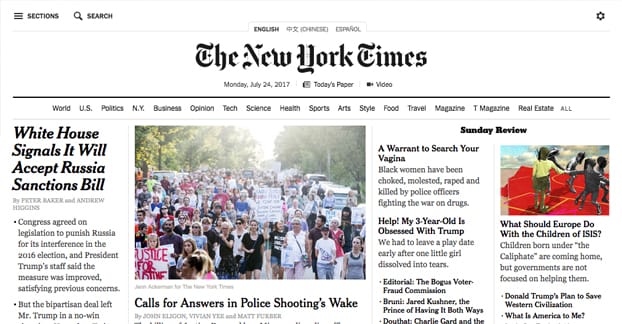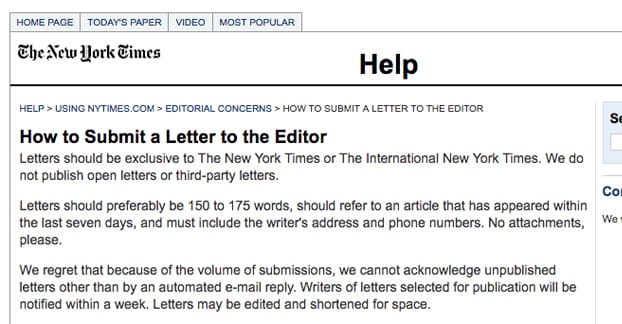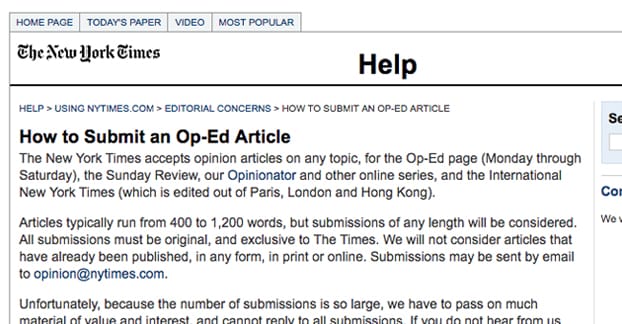The New York Times is an old and venerable institution, a newspaper gone digital, though they have had a print edition in regular publication since 1851. As the website for a newspaper, it’s still formatted to feel like a newspaper, with individual sections for topics like politics, business, art, opinions, food, fashion, and real estate. You can see the full list of categories just by hovering over the drop-down “sections” button in the upper left corner of the site.
Since the New York Times is a newspaper, you aren’t so much “guest blogging” as you are contributing. There are something like 100+ different sections to the online newspaper, ranging from the parenting section Motherlode to the educational Learning Network to the At War section of breaking global news.
Step 1: Figure Out Where To Write
The first thing you need to do, then, is figure out which part of the site is somewhere you can target. If you’re not an international reporter, you probably aren’t going to be able to write for the news in Africa. If you run a blog about fashion, you can probably target one of the fashion sections, like the Men’s Style or Weddings sections. You likely won’t be able to create their crossword, but you can probably write a nice local article for their travel section, particularly if you’re a travel blogger.
Since a large portion of the people who read blogs like this are in some kind of business, marketing, or blogging niche, you can expect to aim for one of those sections. The Tech sections Bits and Personal Tech can have some opportunities, and the Business section is open in the Money, Entrepreneurship, Media, Economy, and a few other sections. Again, however, it depends on your blogging niche.
Basically, since the New York Times is such a big paper with so many millions of readers, they are absolutely swamped with submissions for every possible section on their site. Many of them essentially just disregard any submission that isn’t from an invitation. If you don’t know the editors, or more importantly, they don’t know you, you aren’t going to find much opportunity.
I would say without exaggeration that the New York Times is one of the hardest places to write for simply because you have to compete with so many thousands of other people. Your content must be superior in every way, you must somehow get a good “in” with the site, and you have to avoid squandering your opportunity. There’s no guarantee you’ll get it a second time.
Step 2: Find the Submission Guidelines
Depending on where you want to submit your content, you’re going to have a tough time even figuring out the submission process. Every section is managed by a specific editorial team or a specific editor, and every editor has their own process.
For example, the letter to the editor section has a page for submissions here. A letter to the editor is an exclusive letter specifically referencing an article on the New York Times, within the previous seven days, and it has to include your own contact information. It’s not for guest blogging, of course; it’s 150-175 words and generally made as a correction or expansion upon what was published in the newspaper.
The main reason I link to this page is because they have contact information for a handful of other sections. You can see the list of email addresses halfway down the page. The book review section is [email protected]. The dining section is dining@, the real estate section is realestate@, and so on. This is important, because it lets you contact some sections you might want to write for, and it lets you guess the email address for a section you don’t see listed.
Another contact page is the one for the Lives Essays, which are short, 800-word stories about your life. They tend to be humorous stories rather than anything relating to marketing, but if you’re working on a personal blog and brand, it can work towards both ends.
The Travel section has their own submission process on this page. They have a street address you can send content to, and you can send pitches to an email address. They don’t publish anything that was subsidized or paid for by any organization or promoting an organization, they want content between 1,200 and 1,400 words, and they don’t want photographs.
If you’re capable of producing short documentary-style videos for opinion pieces, the Op-Doc section is award-winning and has a slightly better chance of getting in, simply because the barrier to entry – creating a video – is higher. You can read about that submission process here.
The Opinion and Editorial section is the most open to submissions, with the most visible submission process, but that means it’s also flooded with tons of pitches at all times. They will accept op-ed pieces on pretty much any topic, ranging from 400 to 1,200 words, though longer pieces are occasionally considered. They require exclusivity, but are open to any topic, from business and politics to travel and fashion to entomology and meditation. “Anything can be an op-ed. We’re not only interested in policy, politics, or government. We’re interested in everything, if it’s opinionated and we believe our readers will find it worth reading.”
The Op-ed section submission page is here. You basically just send your pitch to [email protected] and hope they accept it.
One common thread amongst all of these submission processes is the volume. All of them have a “will not necessarily contact you” clause. If you haven’t heard from them by X amount of time – three days for op-ed, two weeks for Travel, etc – consider yourself rejected. They will generally only reach out and respond to you if they’re interested in having you write for them, or if you’re so egregious in spamming them that they’ve blacklisted you.
The op-ed section is both your best and worst chance to get a post published on the New York Times. On the one hand, it’s the most open and accepting of content, since it’s a section specifically designed for accepting guest posts from writers all around the world. On the other hand, it’s the most open and accepting of content, which means there are approximately five billion people trying to submit pitches at any given time. If you thought your email inbox was bad, you should see theirs.
Step 3: Craft and Submit a Pitch
I’m not going to cover writing a pitch in great detail here because I’ve covered it in other sections of the site fairly well. Try reading How to Write the Perfect Pitch and, since you’re likely to be rejected a few times from the Times, check out 5 Strategies to Try if Your Guest Blog Pitch Was Rejected.
When writing a pitch for the New York Times, you can go one of two ways. The first is timely. You see something on the news, or on niche news that you know is likely to hit the mainstream in a day or two, or even in the span of a few hours. You write up a guest blog pitch for that topic, citing your authority in the niche and presenting a good idea for how to cover it.
This is a tricky situation for two reasons. First, you’re probably not the only one looking to cover that topic, and you might not even be the first person to submit a pitch on the subject. Second, if it’s particularly newsworthy, it might be something one of the actual staff reporters for the New York Times is covering, so it could be something you’re just not able to cover. You might have to wait until an actual article is published about it, and then respond to it in a customized way with your expertise.
The second type of pitch is the more informal, opinion or story-based content. Come up with a good anecdote with a good moral that ties into your life and your business somehow, and pitch that. Bonus points if it’s recent or can tie into some modern amount of relevance. There are plenty of opportunities to tie into current events if you just dig into your history a little and get a little creative.
The second type is more likely to get you accepted, but at the cost of requiring a lot more thought and creativity. A basic anecdote about seeing a Muslim help someone and how that ties into politics and so forth is, well, basic. It’s not the kind of stand-out content that’s required to get on the New York Times.
Step 4: Repeat Until You’re Accepted
A simple step, really: just keep at it until you’re accepted or they politely tell you to stop sending them emails. They don’t usually blacklist people, so really, you can keep going as long as you have ideas and the will to keep submitting them.
On the plus side, anything you submit to the New York Times that is ignored and rejected is something you can then adapt and submit to another site. No idea is a wasted idea, they’re just ideas you might need to save for another opportunity. I have a dozen pages of ideas stored away for when the opportunity arises to use them.
Step 5: Read and Sign the Contract
When you’re finally accepted, you will have to go through a process. They will send you an email about accepting your pitch, along with a contract. The contract is you giving them the rights to publish the content and assigning you certain responsibilities. These responsibilities are pretty standard: don’t plagiarize your content, even from yourself. Don’t submit something that has been published anywhere else. Disclose any conflicts of interest, financial or otherwise. You also need to provide all of the supporting information for your story. Cite your sources whenever you state a fact, even if the citation isn’t necessarily going to make it into the finished article.
The New York Times does, in fact, fact check their posts, and they want to make sure that not only are you citing actual, real facts, that you’re also citing them from reputable sources. Don’t just cite your buddy’s blog for a fact with no verification. Cite real sources, authoritative sources. If it wouldn’t make it past a Wiki editing team, it won’t make it here either.
Only once you have signed the contract can you start to work with the editor on your piece. They will have suggestions and guidelines. It’s possible that they didn’t actually like your idea as written, but that they were willing to extract some core value out of it. Maybe they like the scenario but want a different moral. Maybe they want a different direction for your story telling.
Do not worry yourself about the title of the piece. The editor always writes the headline, not the writer. Likewise, it is the responsibility of the editorial team at the New York Times to provide the imagery to go with the post, not yours. This is both so that they can have a consistent visual brand for their paper, and so that they can be guaranteed that they have the rights to use the images they use. It’s just a hassle to accept images from authors.
You also have final veto power. If you are not satisfied with the direction the editor wants to go, and feel like it corrupts your piece or fails to cover the message you want to cover, you can take back the article. They will never publish something you have not agreed to publish.
Don’t worry about adding a shoehorned link to your brand, either. When you publish something, you get a small author box that typically has a link to your email and to your Twitter profile. That, and a small bio, is about all you get. You’ll have to work with their editors to see what all you can fit in. Beyond that, the value comes from having your name and citation on the New York Times, not from a link you post.
 ContentPowered.com
ContentPowered.com








